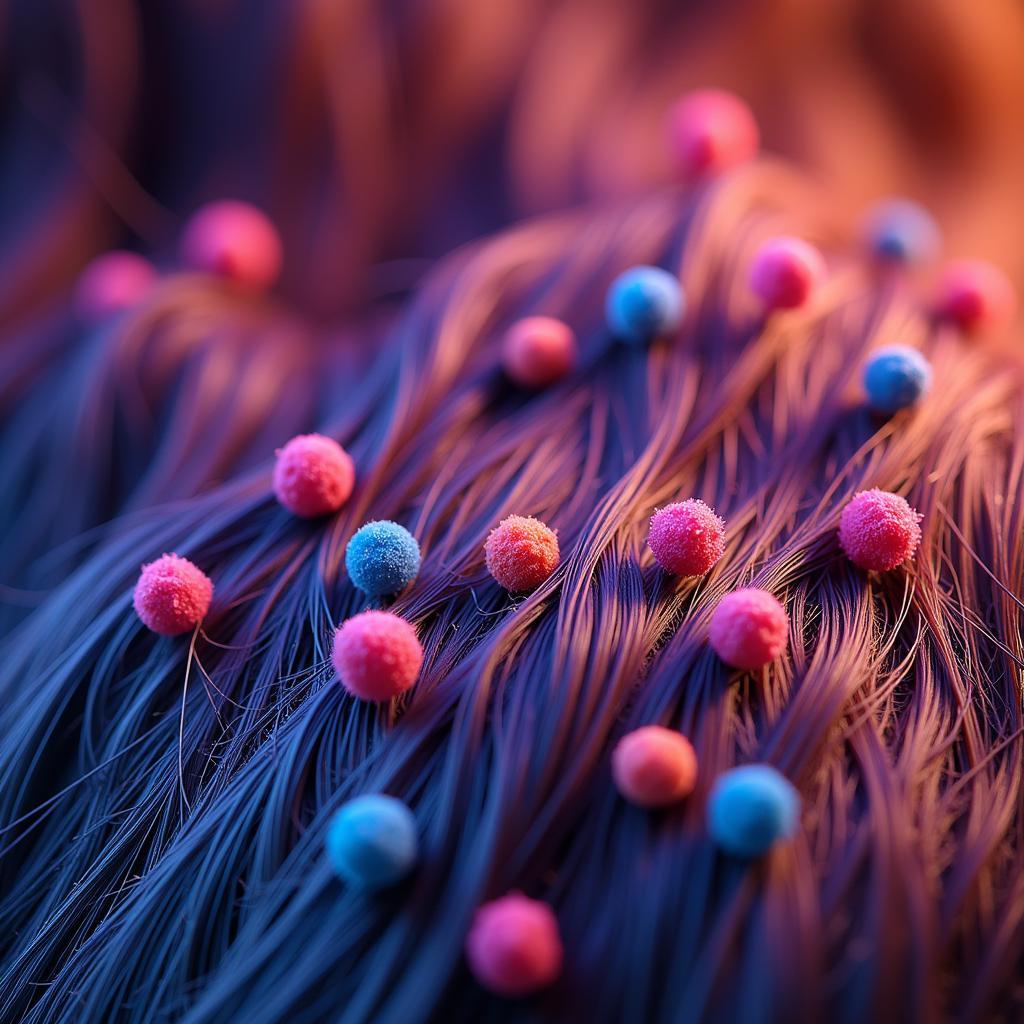Direct dyes are a popular choice for those looking to temporarily change up their hair color or enhance their natural shade. But what exactly are direct dyes and what makes them different from other hair coloring options?
Direct dyes, also known as semi-permanent hair color, are a type of hair dye that deposits color onto the hair shaft without chemically altering the hair’s natural pigment. Unlike permanent dyes that penetrate the hair shaft and permanently alter its color, direct dyes simply coat the surface of the hair. This means that the color will gradually fade with each wash, typically lasting for 6-8 washes or up to several weeks depending on the product and hair porosity.
How Do Direct Dyes Work?
 Direct dye molecules attaching to the hair shaft
Direct dye molecules attaching to the hair shaft
Direct dyes work by binding to the outer layer of the hair shaft, known as the cuticle. These dyes contain color molecules that are small enough to adhere to the hair without the need for developers or ammonia. The color molecules in direct dyes are positively charged, while the hair shaft is negatively charged. This opposite charge attraction helps the color molecules to bind to the hair and create a temporary color change.
The Pros and Cons of Direct Dyes
Direct dyes offer a range of benefits, making them a popular choice for both seasoned color enthusiasts and first-time experimenters. Let’s take a look at some of the key advantages and disadvantages:
Pros:
- Gentle on hair: Direct dyes are less damaging to hair compared to permanent dyes as they don’t contain harsh chemicals like ammonia or peroxide.
- Temporary color: Ideal for those who like to switch up their hair color frequently or are not ready for a permanent commitment.
- Wide range of colors: From vibrant neons to pastel hues and natural shades, direct dyes offer a vast spectrum of color options.
- Easy to apply: Most direct dyes come in user-friendly formulas that can be applied at home without professional assistance.
- Conditioning properties: Many direct dyes are formulated with conditioning agents that can leave hair feeling soft and manageable.
Cons:
- Gradual fading: Direct dyes will fade with each wash, and the color vibrancy might diminish over time.
- Limited lightening effect: These dyes are not designed to lift or lighten existing hair color.
- May not fully cover grays: Depending on the hair porosity and the dye’s pigmentation, direct dyes might not provide complete gray coverage.
- Color transfer: Some direct dyes, especially darker or more vibrant shades, might temporarily stain clothes or pillowcases.
Choosing the Right Direct Dye for You
With countless direct dye options available, selecting the perfect one for your hair can feel overwhelming. Here are a few factors to consider:
- Desired color: Consider the color you want to achieve and how it will complement your skin tone and personal style.
- Hair porosity: Hair porosity refers to how easily your hair absorbs and retains moisture. High porosity hair tends to absorb color more readily, while low porosity hair might require a longer processing time.
- Brand reputation: Opt for reputable brands known for their quality pigments and color payoff.
- Ingredients: Look for direct dyes that are free of harsh chemicals and enriched with conditioning agents.
Tips for Applying and Maintaining Direct Dyes
- Start with clean, dry hair: Wash your hair with a clarifying shampoo to remove any product buildup before applying a direct dye.
- Protect your skin and clothes: Apply a thin layer of petroleum jelly around your hairline to prevent staining, and wear old clothes that you don’t mind getting stained.
- Follow the instructions: Each direct dye has specific instructions regarding application time and method. Always follow the manufacturer’s recommendations for optimal results.
- Use color-safe hair products: To preserve the vibrancy and longevity of your direct dye, use sulfate-free shampoos and conditioners designed for color-treated hair.
- Wash your hair with cool water: Hot water can strip the color from your hair faster. Opt for lukewarm or cool water when washing your hair to help your color last longer.
- Minimize heat styling: Frequent heat styling can contribute to color fading. Reduce the use of heat styling tools or apply a heat protectant spray before styling.
Conclusion
Direct dyes are an excellent option for anyone looking to experiment with temporary hair color without the commitment or damage associated with permanent dyes. By understanding the mechanics of direct dyes, weighing the pros and cons, and following proper application and maintenance techniques, you can confidently embrace a world of vibrant and expressive hair colors.
Do you have any other questions about direct dyes or hair coloring in general? Contact us at Phone Number: 0373298888, Email: [email protected] or visit us at 86 Cầu Giấy, Hà Nội. Our team of color specialists is available 24/7 to assist you with all your hair color needs.

